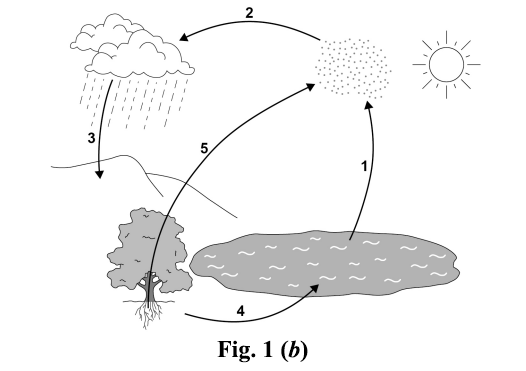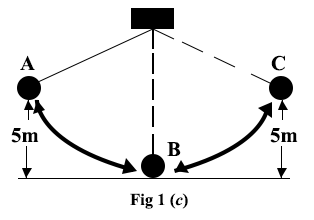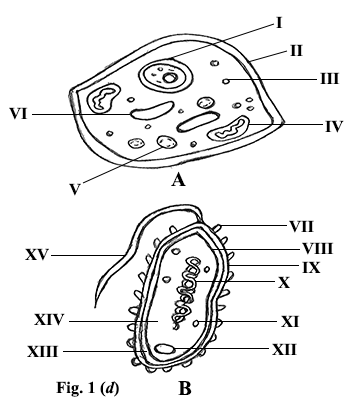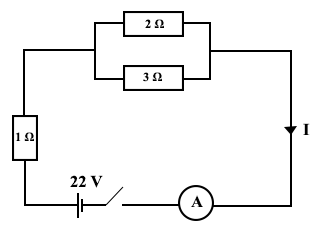1.
All of the following substances can pollute the air except
sulphur dioxide.
fertilizer.
exhaust fumes.
dust.
2.
Which of the following pairs of diseases is caused by insanitary surroundings?
Dysentery and measles
Bilharziasis and dysentery
Cholera and chicken pox
Malaria and cholera
3.
The left ventricle of the heart has the thickest wall because
it is the largest chamber of the heart.
it requires much pressure to pump blood to the heart
the blood, which gets into the left ventricle, is under low pressure.
the left ventricle has to pump blood to all parts of the body.
4.
The part of the eye responsible for changing the size of the pupil is called
iris
lens
retina
cornea
5.
In a simple electrical circuit, the voltage supply is 4.0 V. If the total resistance in the circuit is 3.0 V. If the total resistance in the circuit is 6 Ω, calculate the current in the circuit.
0.5 A
2.0 A
12.0 A
18.0 A
6.
The following statements are all reasons why air is a mixture except
there is no chemical formula for air.
the constituents of air are not in a fixed proportion.
air has weight and occupies volume.
the constituents of air can be separated by physical means.
7.
When white light is dispersed, the following colours are observed except
orange.
yellow.
green.
magenta.
8.
A body of mass 2.5 kg is raised 4.0 m above the ground. Calculate the work.
[Take g = 10 ms-2]
1.0 J
10.0 J
25.0 J
100.0 J
9.
Which of the following instruments does not depend on pressure for its operation?
Siphon
Force pump
Thermometer
Barometer
10.
Which of the following devices operates by going through the following energy transformation?
Electrical energy → magnetic energy → kinetic energy → sound energy
Electric fan
Electric kettle
Electric bell
Transformer
11.
Which of the following confirms that light travels in a straight line?
I. Absorption of light
II. Eclipse of the sun
III. Shadow formation
I only
III only
I and II only
II and III only
12.
Water was added to a quantity of soil and the mixture shaken and filtered. When red litmus solution was added to the filtrate, the filtrate turned blue. The result shows that the soil is
acidic.
alkaline.
clayey.
neutral.
13.
Which of the following gases is not a constituent of air?
Oxygen
Water vapour
Carbon (IV) oxide
Sulphur (IV) oxide
14.
Bodies are weightless in space because
the acceleration due to gravity of the earth balances that of the sun.
of the absence of air.
of the absence of the force of gravity.
the weight of the body exactly balances the force of gravity.
15.
The following are all characteristics of living things except
excretion.
nutrition.
respiration.
secretion.
16.
Atoms which differ in mass number but have the same proton number are referred to as
allotropes.
isomers.
isotopes.
nuclides.
17.
Which of the following statements is/are correct? In the thermos flask,
I. a vacuum is created between the two walls.
II. the outside faces of the glasses are silvered.
III. the heat loss by conduction is reduced by the use of a cork stopper.
I only
I, II and III
III only
I and II only
18.
In the formation of an ionic compound, atoms of one of the combining elements must
convert neutrons to electrons.
gain protons.
gain protons.
gain electrons.
19.
The gas given off during photosynthesis can be identified by using
potassium hydroxide.
a glowing splint.
lime water.
litmus paper.
20.
The new cell formed after fertilization is known as
an embryo.
a foetus.
a zygote.
a seed.
21.
In an electrical circuit, the function of the fuse is to
regulate the voltage in the circuit.
prevent lightning from destroying the appliances.
regulate the flow of current in the circuit.
protect the circuit against excess current.
22.
All the following methods minimize soil erosion except
planting of trees.
creating lawns.
weeding premises with hoe.
creating gutters for running rain water.
23.
In the wiring of houses, appliances are connected in parallel to enable
each appliance to have the same voltage.
power to be saved.
each appliance to have the same current.
the power to be stepped up.
24.
Which of the following structures do all cells possess?
nucleus
Centrioles
Cell wall
Large vacuole
25.
The statement, to every action there is an equal and opposite reaction is
the law of inertia.
Newton's first law of motion.
Newton's second law of motion.
Newton's third law of motion.
26.
In photosynthesis, light energy is converted to
chemical energy.
heat energy.
potential energy.
kinetic energy.
27.
Which of the following gases helps burning and rusting?
Carbon (IV) oxide
Nitrogen
Helium
Oxygen
28.
The egg from the ovary is released into the fallopian tube during
sperm production.
fertilization.
ovulation.
menstruation.
29.
The sperm of a man is produced in the
sperm duct.
testis.
penis.
prostrate gland.
30.
Which of the following part of the tooth may be damaged when hot or very cold food is put into the mouth?
Enamel
Pulp cavity
Dentine
Gum
31.
A body moves with a velocity of 30.0 ms-1. This speed is increased to 40.0 ms-1 in 4.0 s.
Calculate the average acceleration of the body.
17.5 ms-2
8.8 ms-2
4.4 ms-2
2.5 ms-2
32.
A leaf was heated in ethanol before testing it for the presence of starch. This was to
give the leaf a large surface area.
remove the chlorophyll.
soften the leaf.
'kill' the leaf.
33.
A machine does 240.0 J of work in 40.0 s.
Calculate the power developed.
550.0 W
600.0 W
5.5 W
6.0 W
34.
A lever system has a velocity ratio of 4. If an effort of 100.0 N is applied to the system to raise a load of 200.0 N, calculate the efficiency of the system.
50.0%
25.0%
8.0%
2.0%
35.
A body of mass 100.0 kg moves with a velocity of 8.0 ms-1. Calculate its kinetic energy.
400.0 J
800.0 J
3200.0 J
4000.0 J
36.
The reaction between an acid and a base is known as
esterification.
neutralization.
saponification.
sedimentation.
37.
Lime juice tastes sour because it contains
acid.
alkali.
basic salt.
double salt.
38.
A rainbow is observed when rain drops
disperse the rays of the sun.
reflect the rays of the sun.
refract the rays of the sun.
deviate the rays of the sun.
39.
Conduction of electricity is associated with metals because of the movement of
free protons.
free electrons.
ions.
atoms.
40.
Which of the following members in a food chain will receive the least energy?
Grass
Hawk
Lizard
Locust
This paper is in two sections: A and B. Answer Question 1 in Section A and any other three questions in Section B.
Answer all the questions in your answer booklet.
Credit will be given for clarity of expression and orderly presentation of material.
SECTION A
Answer all questions in this section
(a)
Fig. 1(a) is an illustration of the determination of acceleration for three scenarios, A, B and C.
The mass of the trolley in A is 5 kg. 5 kg block is placed on it as shown in B and 10 kg block is placed on it as shown in C.
The trolley in each scenarios A, B and C are being pushed using a force of 300 N. This force causes each trolley to accelerate.
Study it carefully and answer the questions that follow

(i)
Determine the acceleration for each of the scenarios A, B and C.
(ii)
Which scenario has the smallest acceleration and why?
(iii)
Which of Newton's laws is used to determine the accelerations?
(b)
Fig. 1(b) is an illustration of the processes of the water cycle.
Study it carefully and answer the questions that follow

(i)
Name the processes 1, 2, 3, 4 and 5 shown above.
(ii)
In 2007 the population of the world was 6 000 000 000
A study found that 10% of the population had severe water shortage.
Calculate how many people had severe water shortage. Give your answer in standard form.
(iii)
Why do more people have severe water shortage now than in 2007?
(c)
Fig. 1(c) shows an experiment when a pendulum of mass 2 kg swings backwards and forwards.
Study it carefully and answer the questions that follow

(i)
State the energy possessed by the pendulum at A, B and C.
(ii)
Calculate the energy possessed by the pendulum at A, B and C.
[Take g = 10 ms-2]
(iii)
Calculate the velocity of the pendulum at B.
(iv)
If the experiment were repeated on the Moon, the pendulum would swing more slowly. Suggest a reason for this.
(v)
Why would the pendulum come to rest?
(vi)
What is the aim of the experiment?
(d)
Fig. 1(d) shows a microscopic view of two cells A and B.
Study it carefully and answer the questions that follow

(i)
Identify each of the cells A and B.
(ii)
Identify each of the labelled parts I, II, III, IV, V, VI, VII, VIII, IX, X, XI, XII, XIII and XIV.
(iii)
State two similarities between cells A and B
(iv)
State three differences between cells A and B
(v)
State two organisms made up of each of cells A and B
(vi)
State two impacts of organisms made up of each of cells A and B on humans.
SECTION B
Answer three questions only from this section
(a)

Calculate the value of the current I in the circuit above.
(b)
Describe briefly how each of the following mixtures could be separated:
(i)
iron filings and sand
(ii)
crystals of iodine and charcoal
(c)
(i)
What is photosynthesis?
(ii)
Give two reasons why photosynthesis is important in all living organisms.
(iii)
State two conditions necessary for photosynthesis.
(iv)
List two structural adaptation of the leaf for photosynthesis and state how each facilitate the process.
(a)
(i)
Define atomic number and mass number of an atom.
(ii)
An atom contains 11 electrons
(α)
Draw the electronic configuration of the atom and label the parts.
(β)
State with reasons, the type of chemical bond the element can form with chlorine (Atomic number 17).
(b)
A car starts from rest and attains a velocity of 40 ms-1 in 20 s. It maintains this velocity for 30 s and then comes to rest in 25 s.
(i)
Sketch the velocity time graph for the motion.
(ii)
Calculate the acceleration of the body.
(iii)
Calculate the total distance covered by the body.
(c)
What are the functions of the following organs in the digestive system of human beings?
(i)
Salivary gland;
(ii)
Small intestines.
(d)
(i)
What is refraction of light?
(ii)
With the aid of a diagram, show the path of a ray of light as it passes from air to water.
(a)
Describe how you would obtain a pure sample of sodium chloride from a mixture of sodium chloride and sand.
(b)
(i)
What is pH scale?
(ii)
Give the range of a pH scale and explain its significance
(c)
(i)
What is the difference between mass and weight?
(ii)
A piece of wood has density 2 gcm-3 and volume 4.0 cm3. Calculate its mass.
(d)
(i)
What is the composition of blood?
(ii)
Explain how blood carries out its function of defending the body against diseases.
(a)
(i)
(α)
Name the stages in the life cycle of a mosquito.
(β)
Name the stage at which feeding does not take place.
(ii)
Explain how the female Anopheles mosquito transmits malaria to humans.
(iii)
State three methods by which the spread of malaria can be controlled in your community.
(b)
(i)
Distinguish between a covalent bond and ionic bond.
(ii)
For each of the ionic and the covalent bond, give one example each of a compound which contains the bond.
(iii)
Give two characteristics each of covalent compounds and ionic compounds.
(c)
Explain the process of digestion of carbohydrate in humans.
(d)
For each of the following methods of separating mixtures, give one mixture that the method can be used to separate.
(i)
Filtration
(ii)
Sublimation
(iii)
Distillation
(iv)
Use of separating funnel